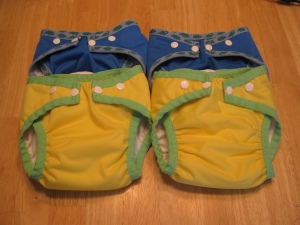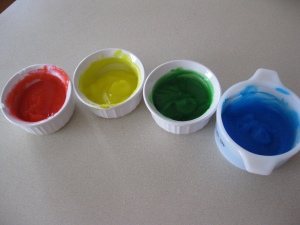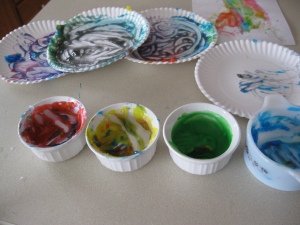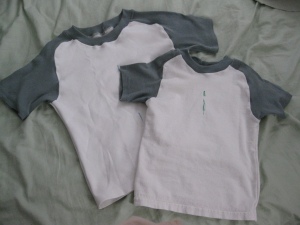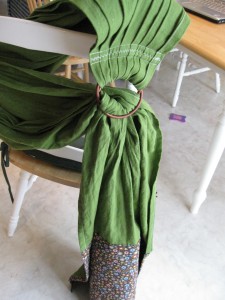Today I made a batch of yogurt, and I thought I would share the process for anyone who is interested. Why make yogurt? There are a couple of reasons that make it worth the minimal time and effort, in my opinion. Here they are, in no particular order of importance:
* You can control exactly what’s in your yogurt. No HFCS, colors, gelatin, nothing you don’t want!
* If you are making organic yogurt, it’s MUCH cheaper to make your own. Organic yogurt can go for $1/6oz cup. I can buy a half gallon of organic milk for $3 and make it into yogurt, 64 oz. worth, which is a savings of about $7 per batch. We eat a lot of yogurt, so this is a big savings for us.
* It’s tasty! And fun! You get to culture bacteria!
Now that you’re convinced, here’s what you need:
*milk (cannot be ultra pasteurized)
*starter cultures (from a store-bought yogurt, can be any kind; I have been using dannon)
*thermometer
*thermos, or other device that holds a steady temperature.
*a pot and a metal bowl
And on to the photo tutorial, so you can see how simple it is!
1) Heat the milk. In the past I have just heated the milk in the pot directly over medium heat. This requires constant stirring though, and I have scorched the milk this way, so I decided to try the double boiler method. Apparently improvising double boilers is common, because I googled “double boiler” and it suggested “makeshift double boiler”, “improvised double boiler”, etc. I’ll save you the trip to google: you simmer water in a pot and put a metal bowl on top. The water level in the pot should be low enough to not touch the bowl. Then heat the milk in the bowl. How much milk? However much fits in your thermos. Mine holds 1.5 quarts. Here’s a picture of me heating the milk in my improvised double boiler:

2) Optional: add some powdered milk. This results in a thicker yogurt. I like thicker yogurt, so I do this, but I suppose I am diluting the wholesome organic-ness of it all. I’m OK with that. It does add calcium and protein, too. I don’t measure, I just sprinkle, about 1/2 cup.

3) Stir this occasionally and check the temperature. It needs to come up to 185 F. It is my understanding that this is to kill any unwanted bacteria (ie. you are re-pastuerizing the milk). No! Further research indicates that it is to alter the proteins in the milk so that the yogurt will thicken. And, that the longer you hold it at this temperature, the thicker it will be. Now, I am no microbiologist, but I have to imagine that this also kills unwanted bacteria, because even pasteurized milk can go bad, hence it must have bacteria. I will have to keep looking into this.
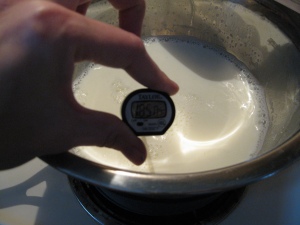
4) Now the milk needs to cool to about 120-115 F. So, take the bowl off the stove, and put it in a pan of cool water. This will speed up the cooling process. Stir occasionally to prevent a skin forming on top, and check your temperature. It’s not a bad idea to warm up your starter to room temperature (you can see mine behind the bowl).

5) Now, to make yogurt, you have to hold the milk at about 110F for a long time. There are lots of ways to do this, but what I have found to be the best is a thermos. So at this point, I pre-heat my thermos by boiling a cup of water and pouring it in the thermos. That way, I don’t drop the temperature of the milk by pouring it into a cold thermos. While you’re at it, make yourself some coffee, because, let’s face it, you’re not getting a nap today.
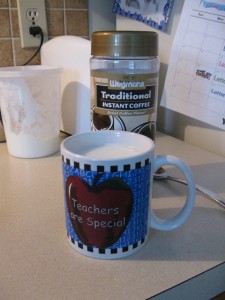
6) Once the milk is at about 120, dump the hot water out of the thermos, and pour in about half of your milk. Then, add your starter culture to the milk that remains in the bowl. I use 2-3 Tbsp. Again, measuring is for sissies. Stir them in well to disperse.
 7) Pour this inoculated milk into the thermos too.
7) Pour this inoculated milk into the thermos too.

8) Put the lid on, and enjoy your coffee and a little snack of yogurt! I finish off my last batch when making the next. Then wait for 6-8 hours, and your batch of yogurt will be ready!

So there you have it! A fun little afternoon project. You can flavor your yogurt with fruit or jam, sweeten with honey, or just enjoy it plain. Some final thoughts:
* The longer you let the milk culture, the more tart and firm it will be. Also, the less lactose will be in the finished yogurt, since it is consumed by the bacteria. Theoretically, yogurt is OK for lactose intolerant people if it is cultured for long enough that the bacteria digest all the lactose. With store-bought yogurt, you don’t know if that is the case or not, so there’s another case for DIYing it.
* You can use the yogurt you made this time to start the next batch, just make sure to save a little! Or, you can freeze a little bit of it to use next time, if it’s going to be a while before you do this again. I think next time I might buy a DanActive and culture that to see if their “immunity boosting” bacteria are really all that.
* Why doesn’t ultra pasteurized milk work? Apparently the process significantly alters the proteins in the milk. Kind of sketchy, if you ask me. But it’s what we buy mostly, because we don’t go through milk fast enough to drink it before it goes bad. Well, that’s another advantage to yogurt, I guess: the good bacteria keep the bad ones at bay, so yogurt stays good for a really long time.
* How long does it take? Not that long, but longer than you think. There’s a lot of waiting for things to heat, and then cool. I like to have something else to work on while I stir intermittently. This time I was cutting fabric. I’m making a quilt for big brother (he picked the fabric), and I’m cutting lots of squares. I can’t find my rotary cutter, so I’m using scissors, one square at a time. It is truly a labor of love.

Anyway, let’s just say it took a lot longer to write this than it did to make the yogurt.
